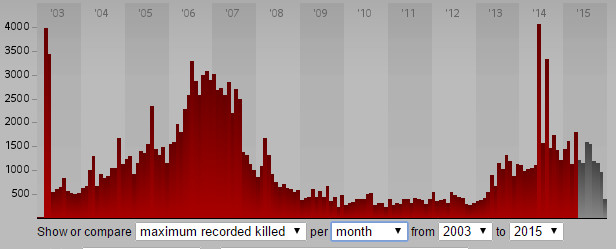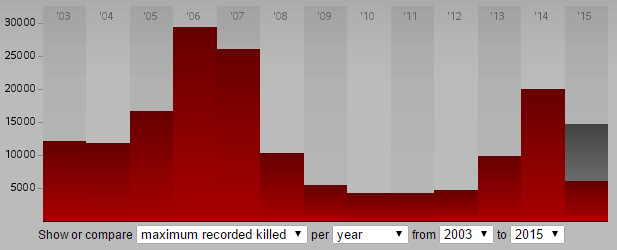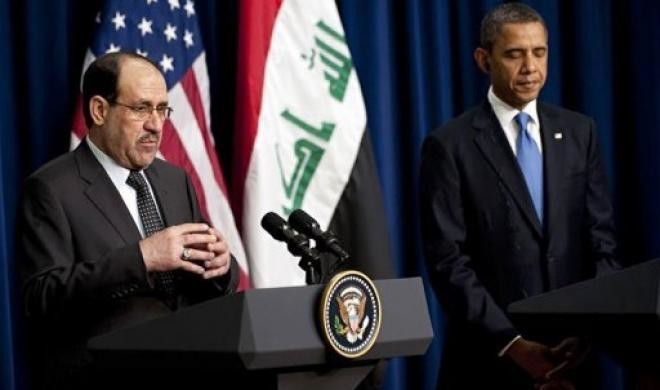People claiming that the withdrawal from Iraq of U.S. forces carried out by the Obama Administration from 2010-2011 explains the rise of the terrorist group ISIS have absolutely no idea what they are talking about. A simple look at the timeline, geography, facts, context, and history concerning the withdrawal and the rise of ISIS makes this abundantly clear and provable beyond any reasonable doubt. Ultimately, Iraqi Prime Minister Maliki’s policies and the dynamics of Syria’s raging civil war are the clear catalysts and drivers behind current crises with ISIS both in Syria and Iraq.
Originally published on LinkedIn Pulse December 16, 2015
By Brian E. Frydenborg (LinkedIn, Facebook, Twitter @bfry1981) December 16th, 2015

Google Images
AMMAN — We keep hearing from prominent Republicans that the Obama Administration’s decision to completely withdraw U.S. military forces from Iraq by the end of 2011 is the primary reason that the Sunni jihadist terrorist group ISIS is now such an enormous problem (not only is this factually wrong, even characterizing the decision as a unilateral Obama Administration move is an oversimplification 1.) since the withdrawal date and terms were set by an agreement made with Iraq by the Bush Administration, 2.) since the Iraqi government, led by Prime Minister Nuri Kamal al-Maliki, refused to give American forces immunity if they stayed behind, the same reason that the Bush Administration did not accept the terms for a longer agreement, and 3.) the American people themselves decided to withdraw from Iraq in voting for Barack Obama in 2008 over John McCain). Below are the top five reasons why the idea that the American withdrawal from Iraq is the main reason ISIS is such a problem today are factually and easily provably wrong:
1.) ISIS’s Roots Go Back Before Obama’s Withdrawal, to the Bush Administration’s Iraq War and the Late 1980s
In assessing what has empowered ISIS, it is important to know how the organization started. There are two paths that led to the creation of ISIS: bin Laden and Zarqawi. Osama bin Laden and his lieutenants created al-Qaeda at the end of the 1980s from among the network of jihadists that were fighting the Soviets in Afghanistan. After the U.S. invaded Iraq in 2003, al-Qaeda began funneling funds to jihadists in/going to Iraq, many of whom eventually followed Jordanian jihadist Abu Musab al-Zarqawi. Zarqawi accepted al-Qaeda support but did not pledge himself to al-Qaeda right away because of significant differences in goals and ideology between himself and bin Laden. After the initial period of operating as an independent group, Zarqawi and his forces eventually did pledge loyalty to al-Qaeda and began calling themselves al-Qaeda in Iraq/Mesopotamia in 2004. While operating in Iraq as an al-Qaeda branch, the group (along with several of its allies) began calling itself the Islamic State of Iraq in mid-October 2006, only a few months after the U.S. killed Zarqawi. By this time, the tensions between the group and al-Qaeda’s central leadership that had existed before the group had pledged itself to al-Qaeda had resurfaced, especially as the group became increasingly brutal, murderous, and extreme to Iraqi civilians, not only many Shiites—whom the Islamic State groups considered apostates worthy of mass execution—but also many Sunnis who were not on board with their extreme vision for Islam; bin Laden and al-Qaeda HQ preferred a more inclusive vision for its operations and one that would focus on attacking U.S. troops, not Iraqi civilians.
Bin Laden’s strategy, in the end, would have been far more successful, because the U.S. was able to crush al-Qaeda in Iraq/the Islamic State of Iraq in 2007 during the “surge” largely because many Iraqi Sunnis—particularly in Anbar province in western Iraq on Syria’s border—joined U.S. forces as allies fighting against the terrorist jihadists in the “Sunni Awakening.” These Iraqi Sunnis joined the Americans after being alienated by the terrorists’ extremist policies, mobilizing Sunni whole communities against them and denying al-Qaeda’s Iraqi franchise safe havens and popular support. This defeat of al-Qaeda in Iraq/the Islamic State of Iraq was over four years before U.S. forces withdrew from Iraq and almost two years before Obama took office.
2.) The Current ISIS Threat Did Not Emerge From Iraq, It Emerged From Syria
After the success of the “surge” and local Sunnis fighting-side-by-side with U.S. forces against al-Qaeda in Iraq/the Islamic State of Iraq ended in crushing defeat for the terrorists, for years after the group was little more than a nuisance and was basically forced underground. Hounded in Iraq, the group saw an opportunity for more fertile ground when the Syrian Civil War erupted in 2011, and under the leadership of Abu Bakr al-Baghdadi(the current self-proclaimed “caliph”), began getting involved there. Over the course of 2012 the group began to play a major and brutalizing role in the conflict, and came to be the most prominent rebel group in Syria over the course of 2013, coming to control large amounts of Syrian territory and growing dramatically in size and power; it was this year when the group began calling itself the Islamic State of Iraq and Syria (ISIS). Baghdadi increasingly clashed with al-Qaeda’s leadership over tactics and aims, leading to a formal split between the two groups in early in 2014; just a few months later, ISIS would use its power base in Syria to launch a major invasion into Iraq, taking much Iraqi territory, much of which it still holds today. Thus, it was the chaos and anarchy of Syria’s brutal civil war that enabled ISIS to rebuild itself and once again become a major threat to Iraq.
3.) Iraq’s Lowest Levels of Violence Persisted Well After the U.S. Withdrawal

Iraq Body Count
If Republican charges about Obama’s withdrawal causing the rise of ISIS had any factual foundation, there would have been a spike in ISIS violence in Iraq after the U.S. withdrawal. This was not the case at all. In fact, according to Iraq Body Count, the worst levels of violence in Iraq were in 2006, when roughly close to 30,000 Iraqi civilians were individually recorded as being killed, and in 2007, when the “surge” campaign took the security situation head-on and saw about 26,000 recorded civilians deaths; that number dropped to just some 10,000 in 2008, to some 5,000 in 2009, and by 2010, when the U.S. began a two-year phased withdrawal, that number was only a little over 4,000. This continued in 2011 as the U.S. completed its withdrawal, and for the entire year of 2012, after U.S. forces had left, that level only went up by a few hundred recorded deaths; the low levels of casualties even continued into early 2013. These levels of far lower civilian casualties from 2010-2012 (during and after the withdrawal) were lower than for any other period since the 2003 U.S. invasion of Iraq (it should be noted that there are some estimates that are much higher and include methodology for accounting for unrecorded deaths, but the trends in the levels of violence are still very clear).
4.) When ISIS Rose to Prominence In Syria, Iraq Was Experiencing Record-Lows in Violence

Iraq Body Count
There were still over 45,000 U.S. troops in Iraq when the Syrian Civil War broke out in March 2011, a level that was maintained through at least part of September, but U.S. troops did not complete their pullout until the end of that year, so one cannot even make the argument that the U.S. withdrawal had anything to do with the start of the Syrian Civil War. On top of this, while the war in Syria raged and saw violence increase dramatically in 2012, record-low levels of violence persisted during that very same year in Iraq and even a few months in 2013. Thus, it is impossible to say that the withdrawal of U.S. forces from Iraq was tied in any significant way to the rise of ISIS in Syria.
5.) Violence Only Increased Significantly In Response to Maliki’s Terrible Sectarian, Oppressive Policies, Not the U.S. Withdrawal

Jim Watson- AFP
If violence did not spike up dramatically after the U.S. left Iraq, but only did so more than a year after the U.S. had pulled out, it logically follows that something else must have been the catalyst and cause for the rise in violence. Fortunately for the curious, it is not difficult to figure out what this was: all available evidence points to only one conclusion, that the policies and leadership of Iraqi Prime Minister Nuri Kamal al-Maliki obliterated the security gains of the “surge” and the final years of the U.S. occupation through sheer sectarianism and oppression. This is undeniable, and especially so when considering that many of the very same Sunnis who had helped the U.S. fight al-Qaeda in Iraq/the Islamic State of Iraq—Sunnis in Anbar province in Western Iraq on Syria’s border and in other places—were so fed up with Shiite Maliki’s sectarian policies marginalizing, oppressing, and brutalizing them, that they rose in full rebellion by the end of 2013. It was this situation and only this situation that allowed the newly renamed ISIS to re-enter in force Anbar province in Iraq when it did, where they entered an alliance of convenience with many of the Sunnis they had formerly fought in the region, and alliance against their mutual enemy: Maliki’s anti-Sunni government. Using Anbar as a base within Iraq, ISIS was able to advance and take large amounts of Iraqi territory, much of which it still holds today. Thus, it was Maliki’s absolute refusal to compromise with and accommodate Iraqis Sunnis and others that created the current crisis with ISIS. The sad truth is that if Maliki had treated the Sunnis and Kurds more fairly, the Iraqi government—Shiites, Sunnis, and Kurds united against terrorism as they were back in 2007—would have been in a strong position to fend off any ISIS incursions coming into Iraq from Syria. If anything, the internal dynamics of Syria spilled over into Iraq, not the other way around, and hardly related in any major way to the U.S. withdrawal. Conversely, if the U.S. had stayed the entire time, shoring up Maliki’s sectarian government that was abusive towards Sunnis, U.S. troops would have almost certainly been fighting both the Iraqi Sunni people and ISIS, hardly a good position for the U.S. to be in and one which, as I recently noted, would have played completely into ISIS’s strategy and in its favor (Putin, ironically, seems to be making this very mistake in Syria with how he is using Russian forces there).
*****
So now, next time you hear people say “Obama pulled out of Iraq and now we got ISIS as a result!” you can tell them they simply do not know the clear history or facts and that their statements are ignorant myths, and explain why this is so obviously the case. In a clear measure of their gross incompetence and how unfit they are for major office, many of the leading Republicans, including many of those dominating the presidential nomination contest and who participated in last night’s debate, are among those spewing and wallowing in this ignorant myth. For any Americans serious about combatting ISIS and terrorism, such politicians should be shunned and dropped from consideration when it comes to votes in the upcoming elections.
If you think your site or another would be a good place for this content please do not hesitate to reach out to me! Please feel free to share and repost on LinkedIn, Facebook, and Twitter (you can follow me there at@bfry1981)